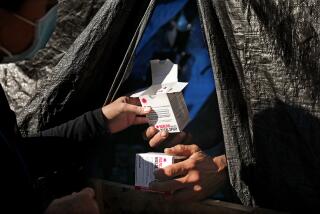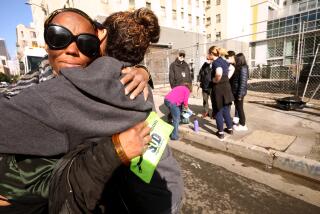Injection That Killed Man Illustrates Health Dilemma : Medicine: The death underscores a growing problem for immigrants and those who cannot afford insurance.
- Share via
RESEDA — Choking back tears, Carlos Sandoval said he knew something was horribly wrong when his mother’s patient fell into convulsions after an injection for a sore throat.
At that point, the woman--Refugio Sandoval--could do little more than pray, he said Tuesday.
Although she had treated scores of patients for illnesses over the past two years in her Reseda home, Sandoval--who is being sought by police--had no training or license to practice medicine in the U. S.
Authorities say the death Sunday of 22-year-old Jesus Nicholas Anchondo in Sandoval’s home underscores a growing problem among immigrants and the working poor.
Many who cannot afford to buy health insurance or to spend a workday waiting for treatment at a low-cost clinic are seeking help from unlicensed, untrained medical practitioners.
Those providing such services range from the local folk healers, such as Sandoval, to swap-meet vendors prescribing brand-name antibiotics smuggled from Mexico.
“It is a matter of economics,” said Prosy Abarquez-Delacruz, local administrator for the state Department of Health Services.
“And some of it is cultural. A lot of people come from countries where the primary health-care practitioner was the local pharmacist, who would give injections on the spot.”
The practice is understandable, Abarquez-Delacruz said.
“With a lot of uninsured patients who have no access to proper medical care . . . they will seek alternatives that are within their reach,” she said. “But it can be deadly.”
Authorities say the illegal prescription and sale of restricted drugs has become a widespread problem among Latinos and Asian immigrants in California, many of whom come from villages where the practice of medicine follows different standards and customs.
State inspectors have identified more than 700 products being sold illegally at swap meets, bakeries and butcher shops.
They include cures for pain, colds, heart conditions, insomnia, arthritis, anemia and kidney infections, authorities say.
Los Angeles police found what looked like a pharmacy stockpile of drugs in Sandoval’s home, including many that appear to have been manufactured in Mexico.
They have recovered the substance used to inject Anchondo, but would not say what it is.
An autopsy is scheduled for today.
Neighbors said Anchondo, who grew up in Pacoima, sought the help of the woman largely because it was affordable and convenient, reasons that authorities say account for the growing illegal trade in prescription drugs and unlicensed medicine.
But enforcement of laws controlling the sale of drugs and the practice of medicine falls to different jurisdictions, prompting the practice to go largely unpunished, authorities said.
The Medical Board of California has the power to revoke the license of bona fide physicians, while county district attorneys are responsible for prosecuting those practicing medicine without a license.
The food and drug branch of the state Department of Health Services is responsible for halting the illegal sales of prescription drugs.
But Los Angeles regional director Abarquez-Delacruz said she can spare only one or two agents to perform the work in an area that reaches from the Mexican border to San Luis Obispo County.
Steve Berchem, spokesman for the Pharmaceutical Manufacturers Assn., said the problem is largely one of enforcement, with little that the firms can do.
Los Angeles Deputy Dist. Atty. Brian Kelberg, head of the division that prosecutes those practicing medicine without a license, believes that the practice is widespread in the Latino community.
But he knows of only one prosecution involving a so-called curandero, or folk healer, in the past 10 years.
In that case, an ailing infant died after being given an injection of aspirin solution.
But experts were never able to determine the exact cause of death or if the curandero’s actions contributed to it.
Malnutrition was also suspected.
As a result, no charges were filed, Kelberg said.
Prosecution is also hampered because customers are seldom willing to report the practice to authorities, especially if they were cured.
Even if they were not, some may fear deportation if they tell.
Generally, cases are reported to police only after a person dies.
“People rarely want to come forward,” said Mike Bryan, supervising investigator for the Medical Board of California in the agency’s Woodland Hills office. “I suspect they are afraid of the system and concerned with being taken out of the country.”
Assemblyman Richard Katz (D-Sylmar), who served on a multi-agency task force looking at the issue until 1992, said drug manufacturers and the government need to warn people of the dangers of seeking medical care and drugs from untrained practitioners.
“We have to go into neighborhoods where English is not spoken and explain to people there are better ways to get health care besides going to the corner and getting a needle stuck in your arm by someone who doesn’t know what they are doing,” Katz said.
Physician Maria Ortiz, of the Northeast Valley Health Corp., a federally subsidized clinic serving a predominantly poor, Latino clientele, said it is common to hear Spanish-speaking patients talk about buying prescription drugs at local swap meets.
The Northeast Valley center’s medical director, Dr. Richard Seidman, said he recently treated an 18-month-old boy for lead poisoning contracted when his parents administered one of two popular Mexican folk remedies for stomach ailments.
“The normal lead level is 10 (micrograms per deciliter of blood). This kid’s lead level was 48 . . . He probably got a teaspoon of that stuff in a cup of tea,” Seidman said.
For many, it is a cheaper and more familiar cure.
In Mexico, especially in rural areas where there are few physicians, residents have learned to depend on curanderos as well as pharmacists.
“There are people who kind of make a living out of injecting other people,” said Miguel Escobar, a spokesman for the Mexican Consulate in Los Angeles.
“When you have (an ailment) on a very minor level or you feel down with the flu, you can go to whatever friend or an old lady who makes her living giving injections to get a shot. That’s a common practice.”
Refugio Sandoval’s son said Tuesday that his mother had studied medicine in Mexico.
“She was only trying to help people,” said Carlos Sandoval, the youngest of Sandoval’s seven sons.
“She was scared. She didn’t want it to happen.”
He said his mother worked as a nurse to those who were too poor to afford traditional medical care.
The small, crowded entryway of the family home served as a waiting room.
Patients needing privacy were seen in her bedroom, which was furnished with a white daybed and a white dresser that served as a medicine cupboard.
Carlos Sandoval said he was sitting at the family’s dining table when he heard Anchondo’s wife scream.
He jumped up from his seat and saw the man in convulsions on the floor.
One of his brothers called 911 and an ambulance arrived. An hour later, Anchondo was pronounced dead.
Neighbors said Sandoval was well-known for her treatments, dispensing penicillin to cure colds, even treating a man for a broken ankle.
Martin Carbajal, 28, of Reseda said that even on Monday, the day after the death was widely reported, as many as six cars stopped by the Sandoval home within half an hour with families seeking treatment.
During an interview Tuesday in the Sandoval home, the telephone rang several times, all patients calling for medical help.
“We are just saying forget about her,” her son said.
Times staff writer Josh Meyer contributed to this story.
More to Read
Sign up for Essential California
The most important California stories and recommendations in your inbox every morning.
You may occasionally receive promotional content from the Los Angeles Times.












